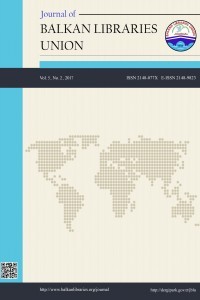Identification, Preservation and Management of Cultural Heritage of Edirne, Turkey by Means of a Web-Based Application
Identification, Preservation and Management of Cultural Heritage of Edirne, Turkey by Means of a Web-Based Application
Edirne, Cultural heritage, Preservation, Online database, Digitization,
___
- Al-Barakati, A., White, M., & Patoli, Z. (2014). The application of workflow management to digital heritage resources. International Journal of Information Management, 34(2014), 660-671.
- Aplin, G. (2002). Heritage: identification, conservation and management. United Kingdom: Oxford University Press.
- Barak, M., Herscoviz, O., Kaberman, Z., & Dori, Y. J. (2009). MOSAICA: A web-2.0 based system for the preservation and presentation of cultural heritage. Computers&Education, 53, 841-852.
- Dimoulas, C. A., Kalliris, G. M., Chatzara, E. G., Tsipas, N. K., Papanikolaou, G. V. (2014). Audiovisual production, restoration-archiving and content management methods to preserve local tradition and folkloric heritage. Journal of Cultural Heritage, 15, 234-241.
- Ekwelem, V. O., Okafor, V. N., & Ukwoma, S. C. (2011). Preservation of Cultural Heritage: The Strategic Role of the Library and Information Science Professionals in South East Nigeria. Library Philosophy and Practice, 95.
- Kioussi, A., Karoglou, M., Labropoulos, K., Bakolas, A., & Moropoulou, A. (2013). Integrated documentation protocols enabling decision making in cultural heritage protection. Journal of Cultural Heritage, 14S(2013), e141–e146.
- Meyer, E., Grussenmeyer, P., Perrin, J. -P., Durand, A., & Drap, P. (2007). A web information system for the management and the dissemination of Cultural Heritage Data. Journal of Cultural Heritage, 8, 396-411.
- Ongena, G., Huizer, E., & Wijngaert, L. (2012). Threats and opportunities for new audiovisual cultural heritage archive services: The Dutch case. Telematics and Informatics, 29, 156-165.
- Pavlidis, G., Koutsoudis, A., Arnaoutoglou, F., Tsioukas, V., & Chamzas, C. (2007). Methods for 3D digitization of Cultural Heritage. Journal of Cultural Heritage, 8(1), 93-98.
- Pieraccini, M., Guidi, G., & Atzeni, C. (2001). 3D digitizing of cultural heritage. Journal of Cultural Heritage, 2(1), 63-70.
- ISSN: 2148-077X
- Yayın Aralığı: Yıllık
- Başlangıç: 2013
- Yayıncı: Balkan Libraries Union
Albanian Book and Libraries in Kosovo
Social Transformation in Turkey by Kemal H. Karpat
Abubakar MOHAMMED, Reuben OZİOKO
Librarians in Crisis of Status, Identity and Marginalization
Implementing Information Literacy through the Personal Librarian Model: Prospects and Challenges
Christopher OWUSU-ANSAH, Vuyokazi GONTSHİ
Gürkan TUNA, Recep ZOGO, Engin Ersin ÇİFTÇİ, Bahattin DEMİRELLİ, Ayse TUNA
The Selection of an Entry-Level Music Librarian: The Analytic Hierarchy Process (AHP) as a New Model
